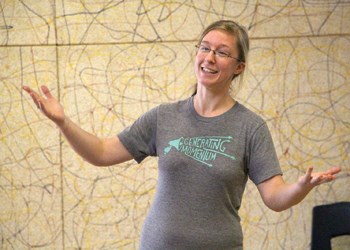As the snow melts and the temperatures again begin to rise, the thoughts of local gardeners turn to the upcoming growing season. The Prairie Sun Seed Festival, now in its fifth year, gave anyone interested in gardening to get information and seeds to get growing.
Stacey Tress, festival co-chair, says that the goal of the event is as much to build community. She says with local producers and gardeners getting together, it’s a way to discuss how to grow and what works in the area. The show is for all experience levels, with one shared goal, to get people growing in the area and learning from each other.
“Personally, for me, I love the accountability of knowing a local producer, knowing where my seed came from, to be able to call up and talk about what worked great this year.”
The growing popularity of the event reflects that people are more concerned with where their food is coming from, what they’re growing in their own gardens and issues surrounding food security, Tress says.
While the garden is the start of the process, the education continues through after the food is harvested, which drives some of the presentations. Tress notes one of the presentations built around how to cook with beans, whether that means getting the most nutritional value or going into unexpected directions, such as cooking a fudge with black beans.
“If it’s related to seed, it has a place here.”
It was a family event as well, and Tress says it’s important to get kids interested in the environment and start helping in their own homes and learning about their own food.
“Their minds are ready to learn, so it’s great to give them those grass roots tips and inspiration.”
Rachelle Ternier with Prairie Garden Seeds in Humboldt was one of the presenters at the event, speaking about organic seed. She says their goal was to get people to learn about seeds and the terminology behind them. She says that there needs to be clarity so people know what they’re growing, eating and feeding to others.
“What do terms like heritage, heirloom, open-pollinated, genetically modified, what do they mean? We throw them around in conversation because they are things that are very important to be talking about, but it’s really hard sometimes to get a clear idea of what things are.”
Food security is one of the reasons why Ternier feels people need to learn about seed and save seed of their own, because she feels it’s important that people become less reliant on mass produced food products and a centralized food system.
“If we don’t take control back in our food system, nobody is going to give it to us. The only way to de-centralize that highly centralized system is to have small efforts all over the place, growing food and seed saving.”
Part of the goal is also to get people more connected to their food and the land, especially as people live in more urban situations. She says that as people save seeds and grow their food, they have a better understanding of nature overall, and that’s why she wants people to try it if they can.
“I really like to stress to people two points that seem opposite to each other. Seed saving is easier than you think it is, growing something and saving the seed from it is not rocket science. Anybody can do it, that means it’s accessible. But at the same time, you do have to be dedicated to taking care of that plant. If you want to have a kid or a pet you’ve got to take care of it, a plant is not as much responsibility... but you do need to consider what it needs.”
She says that the movement is growing, as more festivals such as the Prairie Sun Seed Festival spring up across the province, something she has noticed as there have been a growing demand for seeds and their presentations. She says she sees families as a main driver for an increased interest in food security, as people are more concerned about what they feed their families.
The festival is run by the Assiniboine Food Security Alliance, which has several initiatives in the area, including the community garden and different educational components in the area.
“There are a lot of initiatives. Some of it is actually giving food, and some of it is education,” Tress says.




